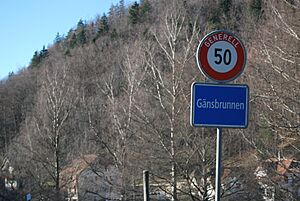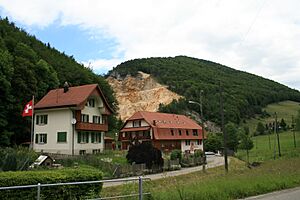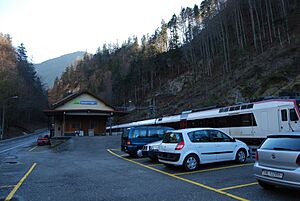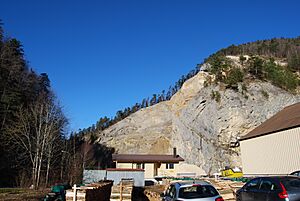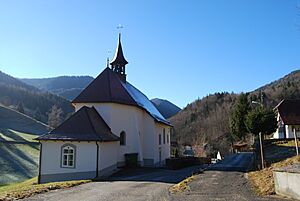Gänsbrunnen facts for kids
Quick facts for kids
Gänsbrunnen
|
||
|---|---|---|
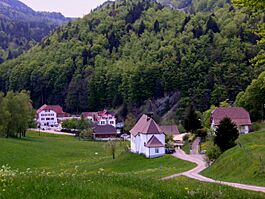
Gänsbrunnen village
|
||
|
||
| Country | Switzerland | |
| Canton | Solothurn | |
| District | Thal | |
| Area | ||
| • Total | 11.44 km2 (4.42 sq mi) | |
| Elevation | 732 m (2,402 ft) | |
| Population
(December 2019)
|
||
| • Total | 82 | |
| • Density | 7.17/km2 (18.56/sq mi) | |
| Postal code |
4716
|
|
| Surrounded by | Corcelles (BE), Court (BE), Crémines (BE), Eschert (BE), Grandval (BE), Herbetswil, Oberdorf, Seehof (BE), Selzach, Welschenrohr | |
Gänsbrunnen was once a small town, also called a municipality, in the Thal district of Solothurn in Switzerland. Its French name is Saint-Joseph. On January 1, 2021, Gänsbrunnen joined with another town called Welschenrohr to create a new, bigger municipality named Welschenrohr-Gänsbrunnen. Before this, Gänsbrunnen was one of the smallest towns in the Solothurn area.
Contents
History of Gänsbrunnen
Gänsbrunnen has a long history! We know it existed as far back as 1428, which is when it was first mentioned in official records.
What is Gänsbrunnen like?
Gänsbrunnen covers an area of about 11.44 square kilometers (about 4.4 square miles). Imagine a big piece of land! A large part of this land, about 66.5%, is covered by forests. These forests are mostly thick woods, with some smaller groups of trees too.
About 29.5% of the land is used for farming. This includes fields for crops, pastures where animals graze, and even some areas for mountain pastures. The rest of the land, about 3.2%, has buildings and roads. There's also a tiny bit of land, 0.1%, that includes rivers or lakes.
Gänsbrunnen is located in the Thal district. It sits south of an old road that used to connect Balsthal and Moutier.
What does the Gänsbrunnen flag look like?
The official symbol, or blazon, for Gänsbrunnen is a green shield with three white geese on it.
Who lives in Gänsbrunnen?
In 2019, Gänsbrunnen had a population of 82 people. Most people living there, about 95.2%, speak German. A smaller number of people speak French.
In 2000, about 29.8% of the people living in Gänsbrunnen were born there. Many others were born in the same part of Switzerland, or in other parts of the country. A small number, about 6%, were born outside of Switzerland.
The population of Gänsbrunnen has changed over time. You can see how the number of people living there has gone up and down in the chart below:

How do people make a living in Gänsbrunnen?
In 2010, the unemployment rate in Gänsbrunnen was 4.4%. This means a small number of people who wanted to work couldn't find a job.
Many people in Gänsbrunnen work in farming. This is called the primary economic sector. Some people also work in mining, which is part of the secondary sector. Others work in the tertiary sector, which includes jobs like working in hotels or restaurants.
Most people who live in Gänsbrunnen and work actually travel to other towns for their jobs. About 21.6% of working people use public transportation, like trains or buses, to get to work. Another 29.4% use their own cars.
What religions are common in Gänsbrunnen?
According to a survey in 2000, about 33.3% of the people in Gänsbrunnen were Roman Catholic. Another 38.1% belonged to the Swiss Reformed Church. Some people belonged to other Christian churches. About 13.1% of the population did not belong to any church, meaning they were agnostic or atheist.
Education in Gänsbrunnen
In Gänsbrunnen, about 44% of the people have finished high school, which is called upper secondary education in Switzerland. A smaller group, about 7.1%, have gone on to get even higher education from a university or a special college called a Fachhochschule.
In 2000, 12 students from Gänsbrunnen went to schools outside of the town.
See also
 In Spanish: Gänsbrunnen para niños
In Spanish: Gänsbrunnen para niños





